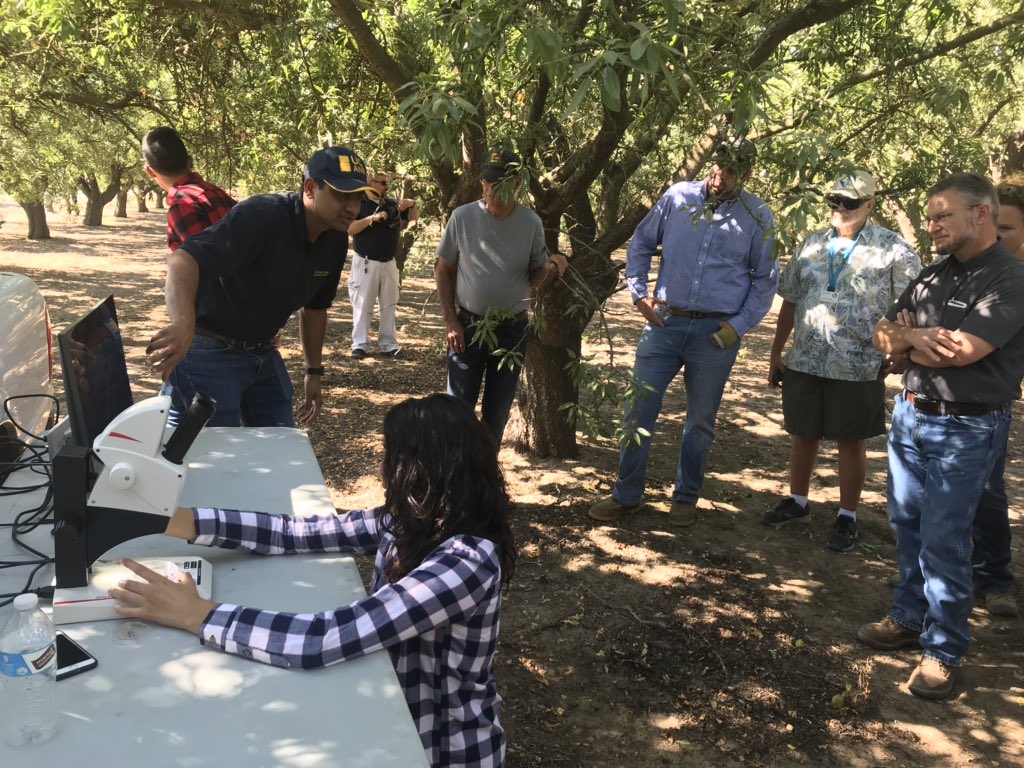Growing up on a small, 10-acre farm on the other side of the globe gave Jhalendra Rijal, UCCE Area Integrated Pest Management Advisor a broad but unique perspective on agriculture and early interest in bugs. The tropical environment of his native Nepal allowed his family to grow an assortment of crops on the land, including rice, corn and a variety of vegetables.
“It was small, but I learned a bit about the ins and outs of the agriculture production system,” said Rijal.
A small farm was all it took to launch Rijal’s curiosity and pursuit of his career in the industry. He obtained his Bachelor’s degree in agriculture, and then went on to earn a Master’s degree in entomology, which complemented his upbringing, his boyhood interest in bugs, and his desire to learn something that would help farmers. Insect pests were encountered every year, resulting in some crop damage in some years. Rijal knew this was the best area to focus his studies and efforts.
“I knew that, even at home, we always talked about ‘how to control these bugs.’ So, I thought this would be something where I could do some good or find something that would be helpful for the growers and for my father, who was doing his production and pest management things at home at the time,” said Rijal.
After spending years studying the effects of insect pathogenic fungi Matahizim anisopliae and Beauveria bassiana in order to control Helicoverpa armigera, one of the world’s most destructive crop pests, Rijal worked with the Nepalese plant protection extension service for three years. It was then that he realized he wanted to push his education even further, and made the leap to the United States for his doctorate, which he earned from Virginia Polytechnic Institute and State University (Virginia Tech).
While at Virginia Tech, Rijal studied grape root borer, a grape pest, in vineyard systems extensively, and worked in over 20 different vineyards, which not only offered Rijal data for his thesis, but also kept him in constant connection with the perspective of a grower. Jumping to the West Coast after his degree, Rijal began working UC Davis, where he spent one year before taking a position with the University of California Cooperative Extension (UCCE) in 2015.
Even in the few years Rijal has been in California, he has seen an incredible increase of nut crop acreage within the state, with some years seeing a 50,000- to 70,000-acre increase. Because of the increase, there has also been a shift in pest control advisors and the amount of land they cover. It has yielded an increased use of new technology and tools, such as GPS-based tech for farm monitoring and electronic traps that work in conjunction with computer or phone apps to read and record data.
Smart spray tech is also nudging its way into the industry with more efficient and precise equipment, application of drone use, and unmanned sprayers commercially available in some areas. “Obviously, the industry is heading in that direction,” said Rijal. “There’s a lot of acreage, a limited number of consultants, and a shortage of labor.”
The combination of these three factors alone will push the industry into new territory. But as the industry is changing, UC Cooperative Extension has changed within the last few years as well.
Interactions between growers and farm advisors were once more person-to-person during farm calls, where advisors would often spend days out in a grower’s field if there was an issue. In the case for Rijal, an insect-related issue doesn’t always require a farm call, as a majority of these issues can be resolved through a photograph or video sent to his cell phone.
“It makes it a lot easier for us, and for growers, too. It also doesn’t cost a trip to the field, or a day out on the farm for a known issue, which is just not possible anymore when one advisor covers such a large area,” said Rijal. “At the same time, walking into a field and observing with the human eye what’s going on in that field has a great value. So, balancing the role of technology and human judgement in the field is important.”
While pest management advisors are scarcer, attention to pest management and available tools is only going to increase in importance. Having worked in Virginia’s agricultural industry for a few years before immersing himself in California’s, Rijal has seen differences in how IPM can be so different from one side of the country to the other, and how IPM is used much more in California. However, the preservation of the currently available tools is something Rijal finds uniquely important.
“There are a lot of IPM practices that we use to make decisions [about management], but at the same time, IPM also needs insecticides and all the other tools and tactics. We’re very limited on the use of pesticides in crops, and while we need to follow these ideals more and more, we also need to think about what tools are available, and how we can preserve them by efficiently and effectively using them, so that we’re not only managing pests, but also preserving our tools so that we can use them in the future.”
For example, navel orangeworm in nut crops is a persistent issue. There are a few active-ingredient pesticides available that focus on navel orangeworm and are effective against the pest. However, the general understanding is that the use of insecticides can only do so much. More importantly, if these tools are used repeatedly without considering the pesticide resistance issue, the efficacy of these pesticides could be lost.
In the last three to four years, collaborative research from the University of California has established that the use of navel orangeworm mating disruption, in conjunction with one or two insecticide sprays, can reduce crop damage in almonds by about 48 percent. This “greener” control tool does little-to-no harm to other non-targets and fits well into the industry’s focus of sustainable production.
Rijal knows a balance must be reached, where the pesticides are not overused, but are still available in times of need. Mummy sanitation is still the foundation of navel orangeworm control in nut crops, and used with mating disruption and other best practices, all these options can work very effectively together.
But every year presents something new, either to the industry as a whole, or to its professionals on a personal level, which creates value in the ability to adapt.
“Before I began my career in the nut industry, I didn’t even know there was a shaker used to harvest tree nuts,” laughs Rijal. “Coming from Virginia and working on vegetable crops, I just didn’t know.”
Rijal quickly adapted, gained a significant understanding of these new systems, has since become well-versed in the almond production system, and is constantly learning new things from growers, consultants, farm advisors, and other people he interacts with. He recognizes that every day is a new day that can present things of intrigue even for the most experienced grower or farm advisor.
“Based on the expertise, we are here to help growers and farmers, pest control advisors, and all of the agriculture industry and community with whatever help they need.”

















